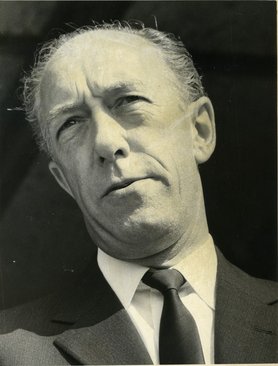Nordic Economic Union (NORDEK): a Danish perspective
The NORDEK plan (so called due to the Swedish name for Nordic Economic Union (NORDiskt EKonomiskt samarbete)) grew out of a Danish initiative to create a Nordic common market. The plan attracted much attention in the years 1967-70. It was the last serious attempt to create a comprehensive Nordic political and economic organisation of cooperation. Disagreement between, amongst others, the Danish and the Finnish about what sort of cooperation there would be with the EEC led to difficulties. After many years of sluggish negotiations, plans were finally given up when the opportunity for Denmark and Norway to join the EEC arose in 1969-70. NORDEK was therefore never realised.

Background
In 1967, the French president Charles de Gaulle de facto vetoed an application for European Economic Community membership by the United Kingdom for a second time. This also led to the question of whether the Danish membership should also be deferred as the UK was one of Denmark’s largest export markets at the time. The Danish Foreign Ministry subsequently took the view that joining the EEC at the same time as the British was not likely to take place any time soon. That being so, the Danish social democratic government and foreign ministry put forward a plan for a Nordic common market.
There were many reasons why the plan was initiated. Firstly, it was considered that a Nordic common market between Denmark, Norway, Sweden and Finland, which would at the same time be a precursor to achieving EEC-membership at a later date, would be able to break the Danes’ dependency on the outcome of the UK’s application. Additionally, it was intended that Nordic economic cooperation could act as a ’training ground’ for Danish industry that, as part of a Nordic common market, would be able to heighten its competitiveness ready for eventually becoming a member of the larger European common market.
Finally, strong Nordic feeling played an important role in the Danish government’s plan. Denmark was generally the keenest proponent of further Nordic cooperation, and this also had political value on the domestic front. If the NORDEK negotiations did not work out and the issue of Danish EEC membership raised its head again, the government’s line could be that it had at least tried to create a vehicle for Nordic economic cooperation.
Negotiations and failure
On the Danish side, the negotiations over the plan for the Nordic common market were conducted by a coalition government made up of three parties, the Liberal Party (Venstre), the Conservative Party (Det Konservative Folkeparti) and the Social-Liberal Party (Det Radikale Venstre) which came to power in 1968. Many of the government’s ministers, including the Prime Minister Hilmar Baunsgaard (who was from the Social-Liberal Party), were Nordic-orientated, which strengthened the Danish desire for a successful outcome. After many cross-Nordic meetings with ministers and civil servants in 1968-69, a draft of a NORDEK treaty was presented in the summer of 1969. The most important element of the treaty was a customs union, but there were also provisions concerning collective institutions and cooperation in other areas, including foreign aid, investments, industry, energy and fishing.

PICTURE: Politician Hilmar Baunsgaard of the Social-Liberal Party, who was Prime Minister and leader of a coalition government from 1968 to 1971, supported Nordic cooperation. Photo: Photographer unknown. Arkivet ved Dansk Centralbibliotek for Sydslesvig.
Despite a draft of a NORDEK treaty actually being writen, there were still many concrete unsolved problems that needed to be negotiated. The problem that overshadowed all others was NORDEK’s relationship with the EEC, where de Gaulle’s departure as president had led to a potential new opportunity for British, Danish and Norwegian membership. The main difficulty was in relation to Denmark and Finland. Finland was not able to accept that NORDEK cooperation would be orientated towards the EEC due to its foreign policy dependence on the Soviet Union. When the negotiations for the NORDEK treaty were completed and it was ready to be signed in the beginning of 1970, Finland was forced to opt out under pressure from the Soviet Union who would not accept Finland’s membership. The plans for NORDEK where thereafter given up. A Danish idea for a SKANDEK, to include Denmark, Norway and Sweden, which arose when the problems with Finnish involvement became clear, were rejected by Norway and Sweden.
Evaluation: an unrealistic project?
Due to the popularity of the idea of Nordic cooperation, none of the Scandinavian countries had an interest in being seen as the country responsible for causing a breakdown in the negotiations. This is perhaps why the negotiations went on as long as they did and came so close to a result, or at least as it appeared in 1969/70. Even without the Finnish ‘no’ however, it is doubtful that the plans could have been realised. Admittedly, the idea was supported by the public and especially the political left. But, even in Denmark where there was most support for the plan, there was not undivided backing. Particularly the right-wing parties and those with agricultural and business interests were sceptical as they were concerned that NORDEK could get in the way of a later Danish EEC membership which was their preferred solution.
Further reading:
- Thorsten Borring Olesen & Poul Villaume, Dansk Udenrigspolitiks Historie: I blokopdelingens tegn, bd. 5 [History of the Danish Foreign Policy: In the sign of the block division, Book 5] (Copenhagen, Gyldendal Leksikon; 2005).
- Lasse Sonne, 'NORDEK: A Plan for Increased Nordic Economic Co-operation and Integration 1968-1970’ (Helsinki University Doctoral Dissertation, 2007).
Links:
- "The Nordek Treaty" i EFTA Bulletin, april 1970 on danmarkshistorien.dk (in English).
- Thanks go to danmarkshistorien.dk for allowing us to translate this article. Read this article in Danish on danmarkshistorien.dk (published 18th August 201).
